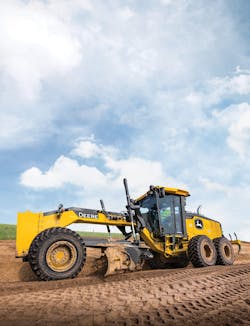John Deere’s Technological Updates in Grade Management and Precision Construction
Grading technology has come a long way. Nowadays, an operator can hop in the cab of a machine and get right to work with the help of integrated mastless grade control technology instead of worrying about installing sensors and managing cables. The built-in global navigation satellite system (GNSS) receivers help visualize where the machine is relative to the grade, allowing precision grading within a fraction of what used to be considered an acceptable tolerance—precision that even a newer operator can produce without years of training and on-the-job experience.
Technology that not only helps prevent over-digging—it saves energy and time.
From Difficult to Easy Mode
Andrew Kahler, Manager of Technology Solutions for John Deere, explains the concept: “A precision construction technology suite consists of grade control technology combined with connected support. For example, our technology portfolio spans multiple pieces of equipment and in order to increase uptime, connected support helps ensure the equipment runs flawlessly and lengthens the intervals between maintenance.”
Kahler notes that a customer who has already been using masted technology on grading jobs can greatly benefit from the Deere integrated technology portfolio. The line encompasses dozers, motor graders and excavators, with the introduction of compact track loaders to the lineup expected this summer. Each category supports a flexible path to precision grade management (entry or premium) based on the customer’s needs.
Not only does Deere’s SmartGrade™ mastless system make life easier for operators, who no longer have to worry constantly about damaging their masts and cables, they’re more easily able to accomplish complex grading tasks. “Finish grading skills can take operators years to develop without this technology. Now, instead of making multiple painstaking passes to get it just right, they can leverage the power of the tech and do it in just one or two passes,” says Kahler.
The Technology
Kahler mentions that entry-level customers can opt for a 2D SmartGrade ready system on their equipment. “This is a lower-priced solution than the premium 3D option, but it’s still highly valuable, allowing the operator to grade constant slopes up and down or side to side, which can be tough to do by eye,” he says. Customers can gain the benefits right away and upgrade to 3D later, if they desire.
Those customers choosing the premium 3D solution can create a three-dimensional model of the job site right on the machine for simpler grading tasks by using points and planes. Kahler says that “for creation of surfaces while onboard, the operator can use the machine’s cutting edge to create points using the topography shot feature. Once these points are generated, they can be used to establish a flat or sloping plane, or can be used to create a three-dimensional surface called a ‘triangulated irregular network.’ (TIN for short)” This process uses computer-generated triangles to create a 3D mesh of the surface, which the equipment can read and utilize to produce the specified grade.
For more complex terrain, the model is generated by an engineering firm using computer-aided design (CAD) software. The desired grade is specified within the design file, and multiple maps may also exist in the file for grading different surfaces of the site, including the sub-base, base, pavement surface and so on. “Once the design is complete, the data load on to the equipment is completed within 30 seconds, with the office wirelessly sending the file over the cellular network directly to the machine by leveraging its onboard JDLink Telematics gateway modem,” explains Kahler.
In an excavator as an example, once the model is in the machine’s onboard system, the equipment guides the work based on the detailed 3D model. The distance to grade is monitored in real time and visually displayed inside the cab for the operator. The system is also capable of setting up virtual floors, ceilings, fences, walls and barriers, and if the machine’s sensors detect whether it’s too close to one of them, an audible and visual alert will be issued. The system can also prevent over-digging the targeted grade, constantly making precise adjustments based on the model.
Benefits on the Job
In the past, precision grading was a fatigue-inducing task, not only because of the level of expertise and attention to detail required to grade by eye—the operator also needed constant situational awareness to avoid a collision. The equipment itself obscures the view of much of the terrain, particularly behind it, but grading operations typically involve a great deal of forward and back motion, creating stress for the operator, who must always remain aware. “Grade control technology can also leverage obstacle intelligence solutions that provide the operator situational awareness,” says Kahler. These systems can enable the operator to see objects that may be in the machine’s path.
In addition, with more uptime and a reduced number of passes required to get the precision of the grade exactly right, fewer machines and less staff are required and can be scheduled for other jobs, improving return on investment. The cost savings can be factored into the bid process, resulting in a more competitive position and the greater likelihood of being awarded jobs.
Then there’s improved sustainability benefits. One success story involves a roadbuilding site managed with just two pieces of equipment, resulting in 29 percent less machine and labor costs than used by traditional methods, as well as material savings and a reduction of 362 metric tons of emissions, the equivalent of 900,000 miles of passenger vehicle emissions.
While traditional grading got the job done, smart precision grading drives a whole new level of speed and precision, notes Kahler. Greater efficiency equals less rework, less wasted material and faster completion.






